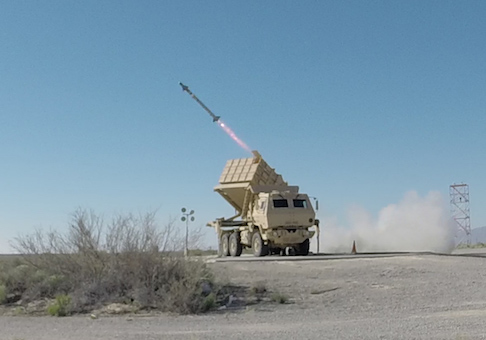The U.S. Army successfully fired additional missiles from its newest launch platform created to provide soldiers with increased protection from enemy fire.
On Monday, the service launched a hit-to-kill missile design to intercept incoming fire as part of an engineering demonstration of the new platform.
"Today’s global security environment demands agile, close-range solutions that protect soldiers and citizens from enemy rockets, artillery and mortars," officials at Lockheed Martin, the company that created the missile, said in a statement Tuesday. "This test is a critical milestone demonstrating the interceptor’s maturity."
The missile was fired off of a "first-of-its-kind" Multi-Mission Launcher, or MML, which was created as a launch platform for a range of interceptor missiles deployed based on threat levels, according to Army officials.
The MML is a ground-based, mobile launch platform containing 15 tubes that can each hold one large interceptor or multiple smaller interceptors, Army officials said in a statement. The platform can rotate 360 degrees and can elevate up to 90 degrees, giving the launcher expansive fire range.
Last week, the Army successfully fired its second AIM-9X missile from the MML and destroyed a cruise missile target, Army officials said. The launch platform also destroyed an Unmanned Aircraft System during the demonstration.
The AIM-9X missile was initially designed as an air-to-air rocket, but the Army recently began using it in ground-to-air simulations.
Army officials said the test last week exhibited the multi-launcher's capability "to fire the system’s baseline interceptor, engage, and destroy a cruise missile."
The missile tests are part of the Army’s Engineering Demonstration of the Indirect Fire Protection Capability Increment 2-Intercept, or IFPC Inc2-1, based at White Sands Missile Range based in New Mexico.
The program was created to offer soldiers protection from cruise missiles, unmanned aircraft systems, and threats from enemy rocket, artillery, and mortar fire, according to Lockheed Martin.
"In addition to the MML, the IFPC Inc 2-I System will use the Integrated Air and Missile Defense Battle Command System (IBCS) for its command and control, a Sentinel radar, and existing interceptors to provide 360-degree protection with the ability to engage simultaneous threats arriving from different azimuths," Army officials said in a statement.
The Army plans to test additional missiles at the White Sands range as part of the program.
